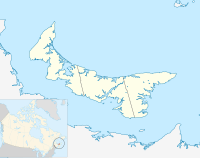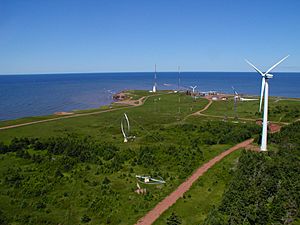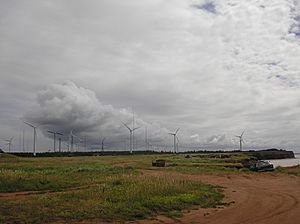North Cape (Prince Edward Island) facts for kids
North Cape is a special place at the very northwestern tip of Prince Edward Island (PEI), Canada. It's part of a small community called Seacow Pond.
This cape is important because it marks where the Northumberland Strait ends and the big Gulf of St. Lawrence begins. Imagine it as a natural border in the ocean!
Right off the cape, there's a long, natural rock reef that stretches for about 2 kilometers (1.2 miles). This reef is made of sedimentary rock and is said to be the longest of its kind in North America.
To keep boats safe, the Canadian Coast Guard has a lighthouse here. It shines a light to warn sailors about the hidden reef. There's also a weather station nearby that helps forecast the weather for the area.
In the summer, people gather a type of seaweed called Irish moss from the shores around North Cape. This seaweed is harvested and sold.
Contents
Visiting North Cape
The land at North Cape belongs to the government of Prince Edward Island. Over the years, they have worked to make it a great place for visitors.
You can find a visitor center here that teaches you about the area's natural history. There's also a gift shop where you can find souvenirs and a restaurant called "Wind and Reef" where you can grab a bite to eat.
If you love nature, you can explore the Black Marsh Nature Trail. This trail is about 5.5 kilometers (3.4 miles) long and lets you see the different fauna (animals) and flora (plants) that live in this unique area.
Wind Energy Institute of Canada
The Wind Energy Institute of Canada (WEICan) is a special place located just south of North Cape. It's a research and testing center for wind energy. It used to be called the Atlantic Wind Test Site.
This center was started in 1980 by the Canadian government and the government of Prince Edward Island. It was created during the 1970s energy crisis when people were looking for new ways to get energy.
Today, WEICan focuses on developing small wind turbines. They test equipment and do research to make wind power better. It's Canada's official place for wind research and development!
The location at North Cape is perfect for testing. It has strong winds, cold weather, and even salt spray from the ocean. This helps them test turbines that will work well in harsh places, like farms or isolated areas, especially in the Arctic. Companies pay a fee to use the institute's testing services.
In 2011, WEICan received a large grant to build a wind energy storage facility. This facility helps them learn how much energy is lost when wind power is stored for different amounts of time.
Hydrogen Village Project
The Hydrogen Village is connected to the WEICan facility. It's Canada's first energy system that can work on its own, without being connected to the main power grid. This system is designed for northern and remote places.
Here's how it works: Electricity from wind turbines is used to split water molecules into hydrogen and oxygen. The hydrogen is then stored in tanks. When there's not enough wind, the stored hydrogen can be mixed with diesel fuel to power generators and create electricity. This project is still being tested to make sure it works perfectly.
North Cape Wind Farm
The North Cape Wind Farm is a group of 16 large wind turbines located near the WEICan facility in Seacow Pond. These turbines use the wind to create electricity.
The wind farm was built in two stages. The first 8 turbines were finished in November 2001, and the next 8 were completed in November 2003. Each turbine is a Vestas V-47-660 model, which means it can produce a lot of power. When all 16 turbines are running at full power, they can generate about 10.56 million kilowatt-hours of electricity each year!
The Prince Edward Island Energy Corporation owns and runs the North Cape Wind Farm. This is a company owned by the PEI government. They raised money to build the wind farm by selling special bonds to people in PEI.
The electricity from the wind farm travels about 28 kilometers (17 miles) through a power line to a substation in Huntley. From there, it's bought by Maritime Electric, which then distributes it to homes and businesses across Prince Edward Island.
Back in 2003, the North Cape Wind Farm was providing about 7.5% of all the electricity used in Prince Edward Island.
Images for kids










